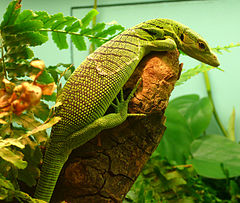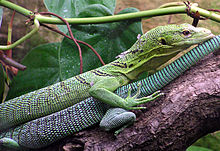Emerald tree monitor
| Emerald Tree Monitor[1] | |
|---|---|

| |
| Scientific classification | |
| Kingdom: | |
| Phylum: | |
| Class: | |
| Order: | |
| Suborder: | |
| Family: | |
| Genus: | |
| Species: | V. prasinus
|
| Binomial name | |
| Varanus prasinus Schlegel, 1839
| |

| |
| Distribution of the emerald tree monitor, shown in red. | |
The emerald tree monitor (Varanus prasinus) or the green tree monitor is a small-to-medium-sized arboreal monitor lizard. It is known for its unusual coloration, which consists of shades from green to turquoise, topped with dark, transverse dorsal banding. This coloration helps camouflage it in its arboreal habitat.[2] It also makes the emerald tree monitor highly coveted by private collectors and zoos alike.[3]
Taxonomy
Varanus prasinus was first described as Monitor viridis by John Edward Gray in 1831; however, Gray's original holotype (RMNH 4812 in the National Natural History Museum in Leiden) was lost and the species was redescribed by Schlegel eight years later as V. prasinus using the found specimen.[4] The generic name Varanus is derived from the Arabic word waral (ورل), which translates to English as "monitor".[5] Its specific name, prasinus, is Latin for the color green.
Evolutionary development
The evolutionary development of V. prasinus started with the Varanus genus, which originated in Asia about 40 million years ago and migrated to Australia and the Indonesian archipelago around 15 million years ago.[6]
Distribution
Emerald tree monitors and their close relatives can be found in New Guinea, as well as several adjacent islands, on a few islands within the Torres Strait and in Cape York Peninsula in Queensland, Australia.[7] The green tree monitor is reported to thrive in lowland environments including tropical evergreen forests, palm swamps and cocoa plantations.[8]
Description

The emerald tree monitor is about 30-39 in (75-100 cm) long with a slender body that helps it support itself on narrow branches. It also has a prehensile tail and long claws that it uses to grip branches.[9][10][2] Unlike other varanids this monitor defends its tail rather than lashing with it for defense when threatened.[11] The soles of the feet of the emerald tree monitor have enlarged scales which aid the lizard when climbing.[10]
Ecology
When threatened, the emerald tree monitor will flee through vegetation or bite if cornered. It is one of the few social monitors, living in small groups made up of a dominant male, several females, and a few other males and juveniles.[2]
Diet
The emerald tree monitor's diet consists of large tree dwelling insects such as katydids, stick insects, cockroaches, beetles, centipedes, spiders, crabs, birds, and small mammals. Before swallowing stick insects, the lizards tear off the legs. Captive specimens tear off the limbs of rodents prior to eating them and as a result they are capable of swallowing mammals of a considerable size: A 135-gram (4.8 oz) lizard was documented as eating a 40-gram (1.4 oz) rodent, an animal almost one-third its size. Unique among monitor lizards, it is the only omnivorous species, supplementing its diet with berries and other fruit.[10]
Reproduction
Clutches consist of up to five eggs, each weighing 10.5-11.5 grams (0.370-0.406 ounces) and measuring about 2.0x4.5 cm (0.79-1.8 in). As many as three clutches are laid throughout the year; captive clutches have been laid in January, March, April, November, and December. The female emerald tree monitor lays her eggs in arboreal termite nests.[10] The eggs hatch between 160-190 days, typically from June to November after which the young eat the termites and the termite's eggs within minutes of hatching.[10] Sexual maturity is reached in about two years.[5]
References
- ^ "Varanus prasinus". Integrated Taxonomic Information System. 28 August.
{{cite web}}: Check date values in:|date=and|year=/|date=mismatch (help) - ^ a b c Wilson, Don W.; Burnie, David (2001). Animal. London: DK. p. 422. ISBN 0-7894-7764-5.
{{cite book}}: CS1 maint: multiple names: authors list (link) - ^ Bartlett, Patricia Pope; Bartlett, Richard D. (1996). Monitors, Tegus, and Related Lizards: Everything About Selection, Care, Nutrition, Diseases, Breeding, and Behavior. Woodbury, N.Y: Barron's Educational Series. p. 63. ISBN 0-8120-9696-7.
{{cite book}}: CS1 maint: multiple names: authors list (link) - ^ Bennett, D. (1995). A Little Book of Monitor Lizards. Aberdeen, U.K.: Viper Press.
- ^ a b King, Ruth Allen; Pianka, Eric R.; King, Dennis (2004). Varanoid Lizards of the World. Bloomington: Indiana University Press. pp. 225–229. ISBN 0-253-34366-6.
{{cite book}}: CS1 maint: multiple names: authors list (link) - ^ Ciofi, Claudio. "The Komodo Dragon". Scientific American. Retrieved 2006-12-21.
- ^ Pianka, Eric R. (2006). Lizards: Windows to the Evolution of Diversity. Berkeley: University of California Press. p. 247. ISBN 0-520-24847-3.
- ^ Cogger, Harold G. (2000). Reptiles & Amphibians of Australia. Sanibel Island, FL: Ralph Curtis Books. ISBN 0-88359-048-4.
- ^ Cogger, Harold; Zweifel, Richard (1992). Reptiles & Amphibians. Sydney: Weldon Owen. ISBN 0831727861.
- ^ a b c d e Greene, Harry W. (1986). Diet and Arboreality in the Emerald Monitor, Varanus Prasinus, With Comments on the Study of Adaptation. Field Museum of Natural History. ISBN 9998057760.
- ^ Robert George Sprackland (1992). Giant lizards. Neptune, NJ: T.F.H. Publications. ISBN 0-86622-634-6.
